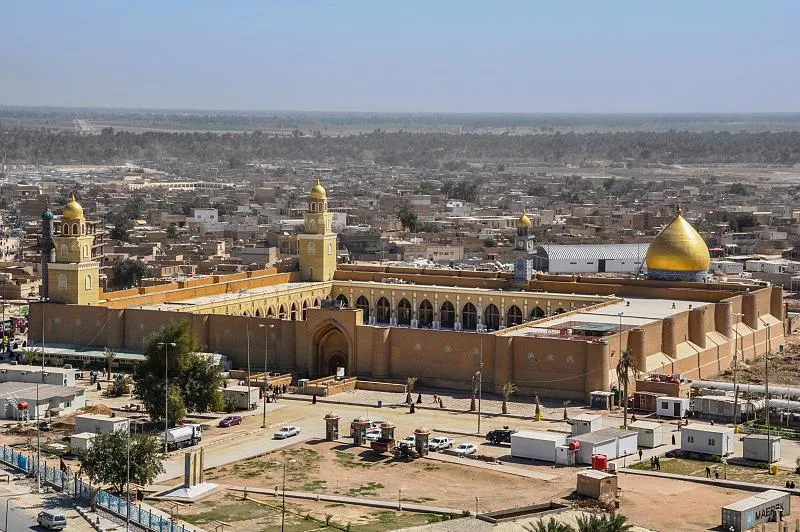A contentious debate has arisen surrounding the preservation of Tell Al Sayyagh, an archaeological site within the historic city of Kufa in Iraq. This dispute reflects a broader and intensifying challenge facing the country due to the application of Iraq’s “investment law”.
Many critics argue that this legislation has enabled members of the State Board of Antiquities and Heritage (SBAH) to sanction the destruction of numerous invaluable historical sites under the guise of legal development. Over the past decade, countless ruins have been irreparably damaged or obliterated, replaced by modern construction projects.
“They are destroying the country’s heritage, and they are doing it legally,” commented one archaeologist, who requested anonymity due to the sensitivity of the matter, reported the Art Newspaper.
Major historical locations have already succumbed to such developments. These include Al-Hira, the pre-Islamic capital of southern Iraq, which has been partly subsumed by Najaf airport; Old Basra, once a major Islamic-era city; and areas of south Hillah near Babylon, including Babylon itself. In Baghdad, remnants from the Babylonian, Sassanid, and Seljuk periods have similarly been demolished.
Tell Al Sayyagh, now under imminent threat, encompasses approximately 75 acres and dates back to the zenith of Kufa during the seventh and eighth centuries. This site remains one of the few undisturbed remnants from that period. Kufa was historically recognised as a hub of intellectual and cultural activity, with its influence still visible today in the development of Kufic script. The city also held significance as a centre for both pilgrimage and commerce.
According to Aqeel Ghaleb Al-Kharifawi, chairman of the Popular Committee for the Protection of Antiquities and Heritage in Iraq, the site offers crucial insight into the structure of ancient Kufa. “Through it, we can deduce the layout of the old city, as it contains buildings for the market for gold and silversmiths and money-changers, who came from the neighbouring kingdom of Al-Hira. Most of these were Christians. Without Tell Al Sayyagh, we have no remaining sites from which to prove this,” he stated.
Modern-day Kufa, now a prosperous city, presents a lucrative opportunity for developers due to soaring land values. In 2017, the Andalusian Wall Company applied to construct a residential complex on the site; the proposal was initially declined on the grounds of its archaeological importance. However, that stance has gradually been reversed. In 2023, the Najaf Investment Authority divided the land—allegedly on arbitrary grounds—and authorised construction on the smaller portion. By March this year, court documents confirmed that the company had received full approval to proceed with a $77 million housing development on the entire site.
Neither Ali Obaid Shalgham, director-general of the SBAH, nor Suhail Al-Tamimi, head of the excavations department, responded to inquiries concerning this change in position.
The public reaction to this decision has been marked by rare and vocal opposition. Protests have taken place in Kufa and Najaf, with widespread condemnation on social media platforms. Such public dissent is uncommon, given that many archaeologists fear professional repercussions. One source noted that a colleague had received administrative penalties after criticising the demolition of a 700-year-old mosque in Basra on social media.
Originally enacted in 2006 and revised in 2010 and 2015, the investment law was intended to promote economic growth and attract foreign investment. Its provisions permit companies to petition for archaeological sites to be reclassified, potentially enabling development. Iraqi heritage sites fall into three categories: A—sites of paramount importance that are permanently protected; B—sites where excavations are ongoing and are supposed to be shielded from commercial activity; and C—sites of limited historical significance. The investment law effectively renders Category B sites vulnerable, allowing development after superficial excavations declare them devoid of major finds.
Despite appearing methodical, these surveys are often hurried and inadequately equipped, archaeologists claim. “These are excavations that should take five to six years, and they do them within months—without proper tools—so that they can say that there was nothing there,” remarked one specialist.
Further allegations suggest financial motivations behind these decisions. The law has disproportionately been applied to sites in urban areas with high land value, while more isolated locations remain largely untouched. As Iraq’s economy continues to expand, the risk to its archaeological heritage appears to grow in tandem.
“If the law continues to work in this way,” one critic warned, “the archaeological sites will be destroyed and no rich sites will remain in Iraq.”
The case of Tell Al Sayyagh underscores the urgent need for a more balanced and transparent approach to heritage management—one that respects the irreplaceable value of the past while navigating the necessities of the present. If unchecked, the current trajectory threatens to leave future generations with little more than stories of what once was.
